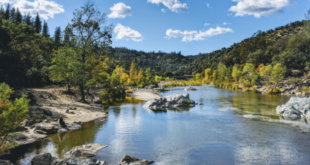The miners of the 1800s California Gold Rush were determined to strike the Mother Lode for riches and fame, and are responsible for introducing mercury to the Sierra Nevada. Mercury was used to process mining ore for gold. That mercury has remained in the Sierra Nevada and led to the contamination of sediments throughout Sierra watersheds.
Fast forward to 2018 when from Oct. 1 to Nov. 19 when some 40,000 cubic yards of sediment were removed from the dry Combie Reservoir lakebed, an impoundment of the Bear River flowing along the Placer and Nevada County line in northwestern California’s Gold Country. The removal of sediment from Combie Reservoir while introducing an innovative mercury recovery process is a three-year pilot project. The unique project and process has earned the Nevada Irrigation District’s (NID) Combie Reservoir Sediment and Mercury Removal Project team members the prestigious 2018 Small Project of the Year award, presented by the American Society of Civil Engineers, Sacramento Section.
Benefits of the Combie Reservoir Project include restoring water storage capacity in an existing surface water reservoir and removing mercury from the Bear River watershed as well as creating long-term benefits to downstream aquatic habitat. Findings from this project will become valuable to state regulators and water managers in helping them to address mercury in the aquatic food chain. When complete, this project can act as a replicate process, applied at other impacted reservoirs.
NID is working with numerous partners to aid in the project and help in ensuring its success. Partners include the Cosumnes-American-Bear-Yuba Integrated Regional Water Management Group (CABY), the Department of Water Resources, Great Lakes Environmental, NV5 Global, Inc., Sierra Fund, US Geological Society and Teichert Aggregates.
The second phase of the NID Combie Reservoir Sediment and Mercury Removal Project is currently underway and will continue through August of this year. This phase is focused on removing sediment in wet conditions using a suction dredge. Once the material is out of the reservoir, a centrifuge technology will be used to remove elemental mercury.
 California Water News Daily Your Source For Water News in California
California Water News Daily Your Source For Water News in California


